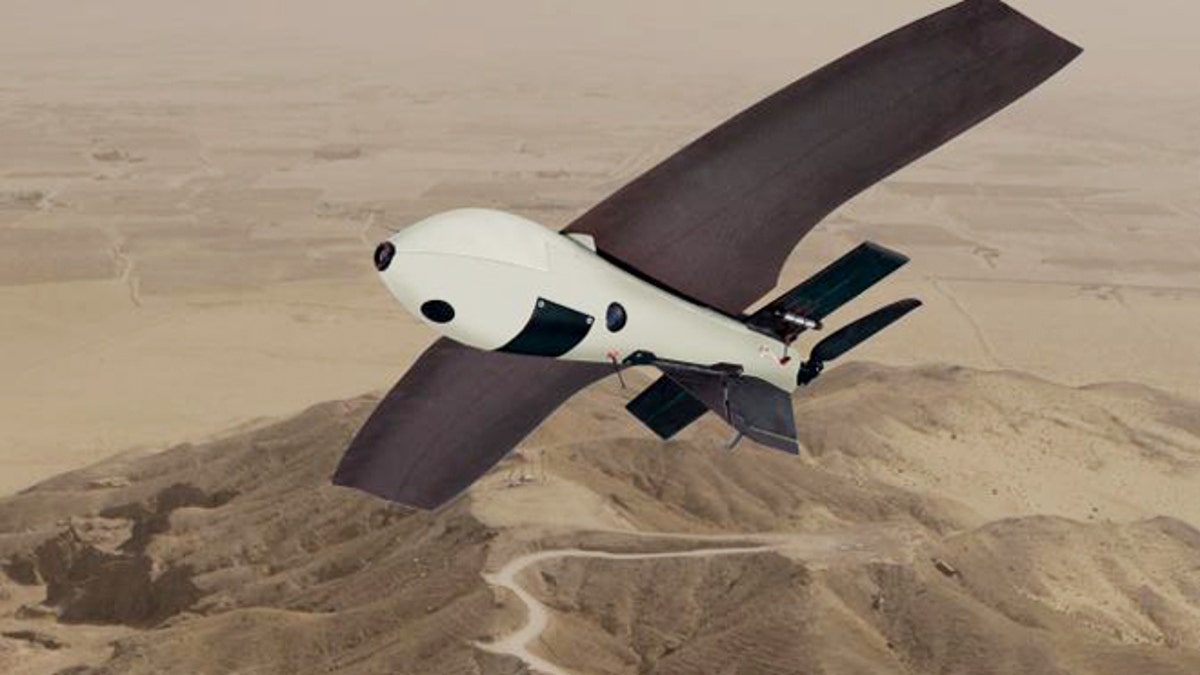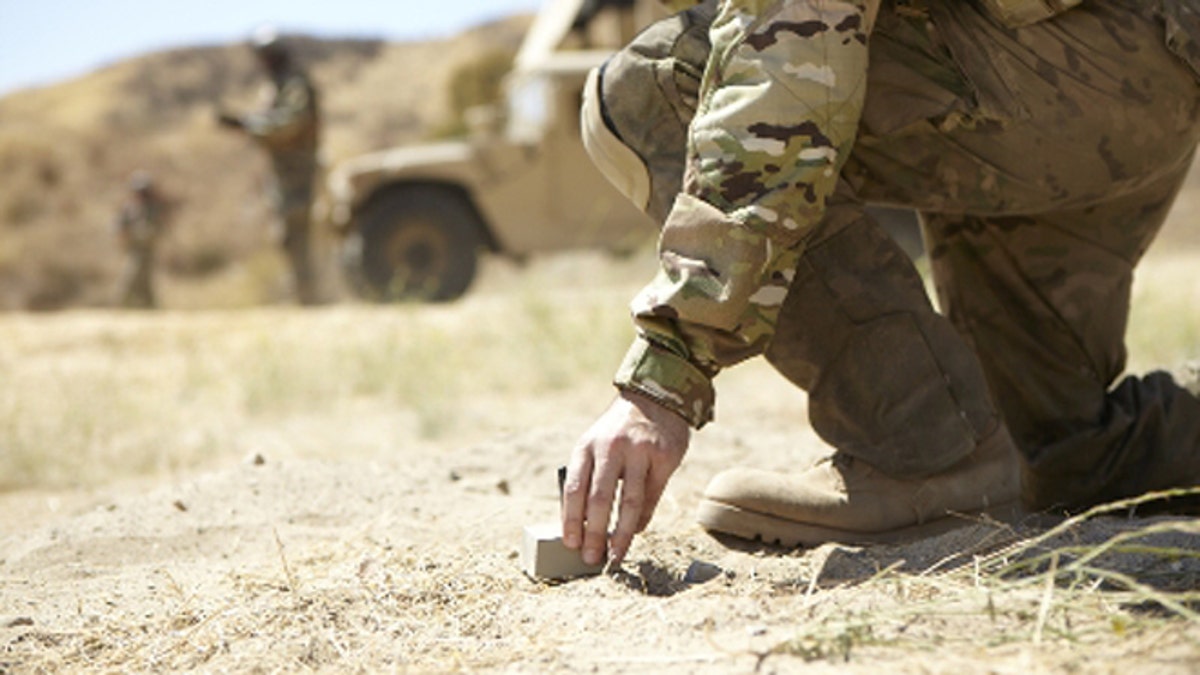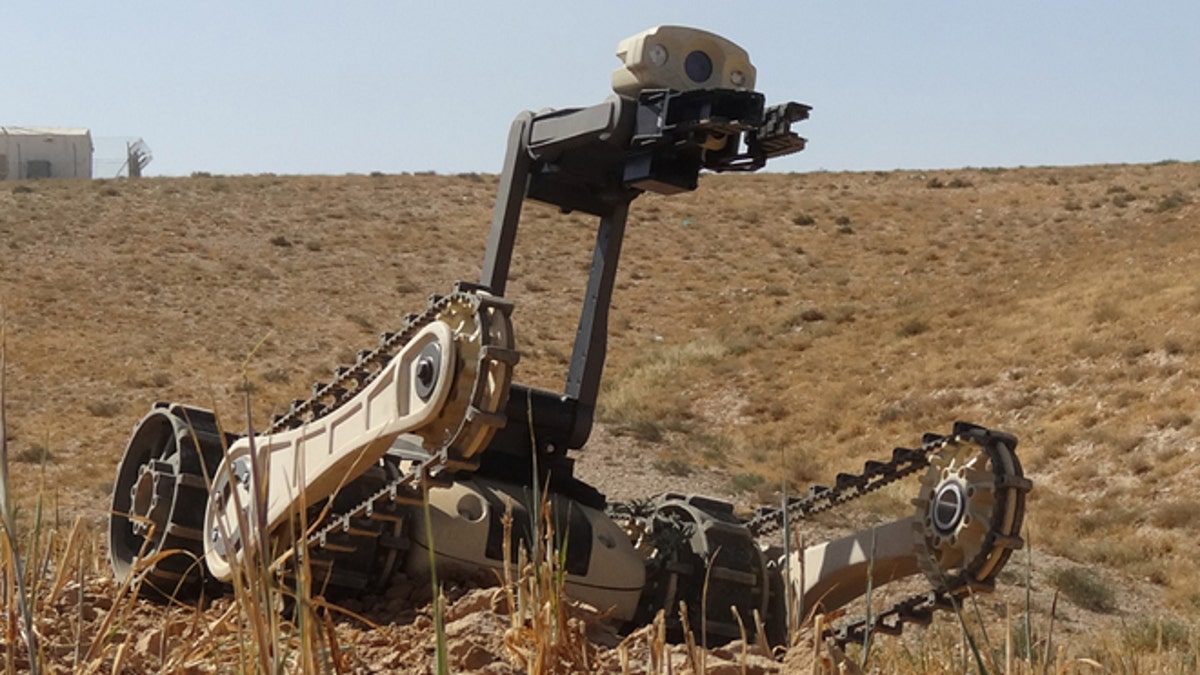What do a kamikaze drone, a “field and forget” surveillance system and an Israeli robot have in common? Buzz at the annual AUSA Army meeting in Washington, D.C.
Here are three new pieces of tech revealed at this year's show.
1. Battlehawk drone blows itself up

Textron unveiled BattleHawk, a new kamikaze drone that blows itself up -- and takes its target with it. (Textron Defense Systems)
A new “kamikaze” drone that blows itself up -- and takes its target with it -- was revealed at AUSA.
Made by Textron System, the Battlehawk is similar to Aerovironment’s widely publicized Switchblade. Both are drones that can be carried in a backpack and hand-launched. And they both represent a movement towards making drones more accessible at a squad level.
Rather than call in air support, a squad would have a drone literally in their hands to deploy against threats like a sniper or an ambush waiting around the corner. The Battlehawk is made of carbon-fiber wings – wings that can be curled up for deployment from a 22-inch tube launcher.
The 5.5-pound Battlehawk runs on a small battery-powered propeller. This drone can be flown using a mere tablet or smartphone equipped with the Android app.
It also has an onboard video camera system so the users can monitor the mission in progress.
Battlehawk can follow a target for half an hour using a geo-location device, or the pilot can choose Attack or Abort Mode. Using the controls, the grenade in the drone’s nose can be armed in flight.
While this drone could be used to target enemy vehicles and locations, beyond military applications, Textron has hopes for homeland security applications as well. Rather than using a lethal grenade, Battlehawk could be armed with less lethal alternatives like a smoke grenade for deployment domestically, for example.
This autumn the Battlehawk will be deployed for more testing by forces.
2. Rocks to monitor enemy movements

The SPAN sensor system from Lockheed can be easily concealed in camouflage housing. For example, one option is for the sensor to look like just your average rock. (Lockheed Martin)
Lockheed Martin chose AUSA to reveal more information on the company's field-and-forget surveillance system called Self-Powered Ad-hoc Network or SPAN.
So what is SPAN? Basically it looks like rocks, but acts like smart sentries.
SPAN is an integrated sensor system that functions as a self-forming mesh to provide covert surveillance for protecting bases, borders and more.
And get this: These sensors are self-healing, self-powering and self-organizing. This sensor network is so smart it can direct a camera or drone to investigate an area. Or say the “rocks” were in place to monitor oil pipelines … the system is so smart it can notice a pipeline in danger of fracturing and call an engineer.
The sensors can be easily concealed in camouflage housing. For example, one option is for the sensor to look like just your average rock.
Small enough to be fit into a hand, not only do the sensors operate with extremely low power but they harvest their own energy from their surroundings.
That’s right, this surveillance system powers itself. It can operate nearly perpetually without someone going out to the “rocks” and replacing their batteries.
Using solar panels, for example, it can harvest simple energy from its surveillance position.
When you combine convincing rock disguises with self-sustaining power, you’ve got a difficult to detect, highly concealed surveillance system, with a reduced chance of the enemy discovering it and dismantling or tampering with it.
3. Special Operations Stair-Climbing Robot

Designed by the Israeli Roboteam company, the Micro Tactical Ground Robot is a stair-climbing micro robot to deploy on special operations missions. (Roboteam)
Also announced at AUSA, the U.S. Defense Department is fast-tracking deployment of a stair-climbing micro robot to deploy on special operations missions.
Designed by the Israeli Roboteam company, the Micro Tactical Ground Robot (or MTGR) can be carried by a single soldier. MTGR travels at 2 miles per hour and can climb 8-inch stairs, and this tough little fella can carry its own weight.
The micro robot was also built to clear obstacles and conduct complex maneuvers in extreme terrain with a line-of-sight operating range of 1,600 feet. To that end, it has five on-board cameras, an internal microphone and infrared laser pointers that can pinpoint a target 360 degrees around the robot.
Its encrypted radio allows streaming secure voice and video to tactical operators downrange.
Roboteam’s Ruggedized Operator Control Unit, which comes in a 5-inch Android version and a two-handed, 7-inch Windows-based unit, controls the robot, its manipulator arm and onboard tech.
A robot this size equipped with this tech would be useful for situations involving tight spaces where a warfighter or canine would not fit or easily maneuver. For example, it could be used for underground threats like investigating tunnels in war zones.
MGTR is also built for to help dispose of explosive ordnance. At 20 pounds, the company says it is the world’s lightest such platform.
The micro robot is in operational tests with the Pentagon’s Combating Terrorism Technical Support Office who announced 100 of these robots will receive “priority fielding” to special operations forces.
The Pentagon expects Army Special Operations Command, Naval Special Warfare Command, Marine Corps combat engineer schoolhouse and the FBI’s Hostage Rescue Team to use these micro robots.
35 more of these robots will be deployed for domestic use by interagency tactical units.
Ballet dancer turned defense specialist Allison Barrie has traveled around the world covering the military, terrorism, weapons advancements and life on the front line. You can reach her at wargames@foxnews.com or follow her on Twitter @Allison_Barrie.
